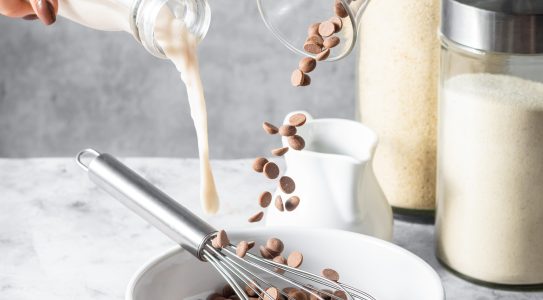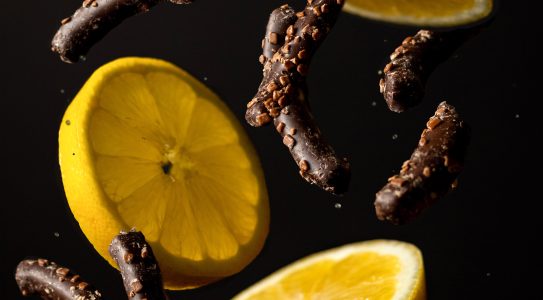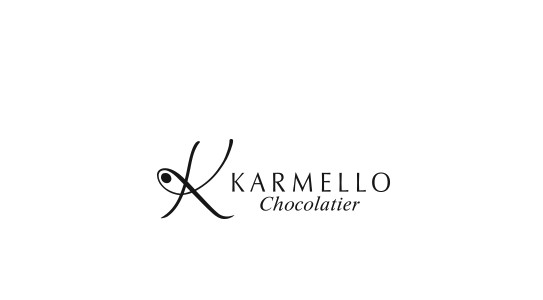Fruits covered with chocolate
The possibility of combining fruits and chocolate is a true field of exploration for those who love these products. The flavor of fruits perfectly complements the world of chocolate. I love the combination of chocolate with lemon zest, pineapple that brings a fresh note, orange bringing freshness, or kiwi delivering a bit of exoticism. This offer of chocolate-fruit fusion is completed with slices of ginger and many spices, such as green or red pepper, as well as nuts or other seeds.
Marcin Paździor His passion for chocolate began at a young age, and he can create both refined pralines and unique chocolate sculptures. He has over 20 years of professional experience, 10 of which he spent leading the Chocolate Academy in Łódź. He has participated in many prestigious pastry competitions and has also been a judge for the international “World Chocolate Masters” several times. He currently works at Karmello Chocolatier as a chocolate master.
Selection of chocolate to match fruit varieties We can prepare fresh, dried, candied, or freeze-dried fruits, and the chocolate should match the fruits. When choosing, it is best to follow your own taste. There is a very wide selection of chocolate varieties available. White chocolate goes best with raspberry or lime, milk chocolate with blueberries, and dark chocolate with oranges and of course with strawberries.
Preparing fresh and frozen fruits Markets in the summer are full of fresh fruits! I recommend all berry fruits in chocolate. It is important to remember that fruits such as strawberries, raspberries, blueberries, or blackberries should be washed gently but never eaten unwashed. First of all, street dust settles on them, and besides, snails may have walked over them, spreading the larvae of a certain type of tapeworm. We should also remember that fruits contain a lot of sugar. If we want to have tasty fruits all year round, it is worth freezing them. Freezing time – from 3 to 12 months at a temperature of -18°C or lower. Freezing can damage some soft fruits, but this does not pose a health risk. The speed of freezing is important. The faster, the better the quality of the frozen fruits. Slow freezing creates large ice crystals that tear the cell membranes of fruit tissues, causing juice to leak during thawing. After thawing, fruits may also lose their firmness and crispness. And products that have a high fat content may become layered. Industrial freezing is much faster, and smaller ice crystals are formed. That is why there is no such problem with industrially frozen fruits.
Preparing fruit for drying Drying temperature: about 58°C. There is really no right or wrong way to prepare fruit for drying. By following a few tips, you can achieve the desired success. First and foremost, it is important to maintain even slice thickness and use a pre-treatment that will help preserve the color, nutrients, and texture. There are two methods of pre-treatment: soaking (primarily used to prevent the fruit from oxidizing) and blanching.
Soaking fruit
Bath in fruit juice Citrus juices such as pineapple, lemon, or lime can be used as a natural antioxidant. Mix one cup of juice with one liter of lukewarm water and soak the products for 10 minutes (note: fruit juice is only 1/6 as effective as pure citric acid and may affect the taste of the preserved products).
Bath in honey Honey baths are often used for drying fruit. Many dried fruits sold in grocery or health food stores have been subjected to this treatment. Honey will make the fruit much sweeter and add calories to it. Dissolve one cup of sugar in three cups of hot water, allow the mixture to cool to room temperature, then add one cup of honey. Dip the fruit in small batches, remove with a slotted spoon, and drain thoroughly before drying.
Blanching – preventing fruit browning Blanching as a pre-treatment method can be done in boiling water or steam. The pre-treatment is often called cracking. This method is most effective for fruits with a hard skin (sometimes having a natural protective wax coating), such as grapes, plums, blueberries, etc. Boiling the fruit in water for 1-5 minutes cracks the skin and makes it easier for moisture to escape, shortening the drying time. If you want to preserve the green or other natural color of the fruit, add table salt to the hot water during blanching. After blanching, pour sugar syrup over the fruit. Remember to pour cold syrup over soft fruits, such as strawberries or raspberries, and hot syrup over hard fruits. After pouring the syrup over the fruit, leave it to saturate for at least 12 hours. It is best to use a sugar solution with a sugar content of 50% to 75% – depending on the type of fruit. The sugar solution recipe should include an anti-crystallizing agent in the form of potato syrup or inverted sugar. The sugar solution should contain about 70% sugar, 25% potato syrup, and 5% glucose.
Candied fruits In confectioneries, candied fruits are often used. They are obtained by heating the fruits in syrup to reduce the viscosity of the sugar solution and thoroughly draining the fruits from the syrup. Dried fruits are added to a prepared sugar solution with a sugar content of 80% (called candy) and lightly mixed. Turbidity of the solution will indicate poor sugar crystallization. Then the fruits are removed from the candy and placed on racks. After drying, the candied fruits, also called “cykata,” can be used for production – for example, by coating them in chocolate.
Freeze-dried fruits The process of lyophilization is nothing more than very rapid freezing of a given product, followed by removal of the water from its structure. This procedure results in minimal water content in fruits, which inhibits all biological reactions (such as bacterial or fungal growth).
Improper storage can reveal the appearance of chocolate
Fatty film – may appear on chocolate due to excessive heat or too large fluctuations in temperature. Sugary film – significant temperature fluctuations cause condensation: droplets of water can appear on the surface. Oxidation – the oxidation process releases fats from the chocolate, causing it to smell unpleasant and lose its taste. Hardness of fruits – the cause of excessive hardness of fruits may be their immaturity. Wrinkling of fruits – can be the result of too rapid diffusion of the sugar solution or too long blanching. Discoloration of fruits – the result of insufficiently long blanching or use of a sugar solution with too low acidity. Fruit breakdown during production – the use of ripe fruits causes them to break down during production. Crystallization of sugar syrup – too little anti-crystallizer content.



